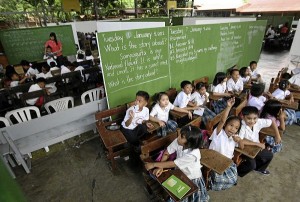MANILA, Philippines—Millions of Filipino schoolchildren may end up having to pay more for their school supplies come June if the government decides to impose higher tariffs on imported paper used in the local production of books, notebooks, pad paper and similar items.
At the same time, paper importers, traders and printers have also warned that any move by the Department of Trade and Industry (DTI) to artificially shore up the local paper manufacturing industry through protectionist policies would eventually backfire on the country’s international competitiveness.
“Why should the government penalize millions [of end users of imported paper] just to benefit one local manufacturer?” Association of Paper Traders of the Philippines, Inc. (APTP) president Sammy Rosario said in an interview with the Inquirer.
Protect industries
Rosario was referring to a petition filed by Trust International Paper Corp. (Tipco) in May 2012 asking the DTI to raise the duties on imported paper, ostensibly to protect the domestic newsprint industry, which the company dominates.
The imposition of higher import duties is a provision of Republic Act No. 8800, the Safeguard Measures Act, which allows the government to protect fledgling domestic industries against competition from cheaper imports.
Rosario pointed out, however, that the domestic paper manufacturing sector could hardly be considered an infant or sunrise industry since it had been in operation for many decades, with little to show by way of improved efficiency or higher competitiveness against late-starting foreign paper manufacturers.
Superior quality
Should the DTI decide to raise the duties on paper—specifically news-print—imported from countries like South Korea and Russia, the pain would be felt most by schoolchildren and their parents who would have to pay more for paper-based school supplies.
More importantly, however, the APTP head pointed out, imported newsprint used for everything from books to notebooks to newspapers was superior in quality to that produced by Tipco.
“Why must the government force the public to pay more for lousy paper?” he said.
Substantial losses
In its 2012 petition to the government, Tipco pointed out that it remained the only player in the newsprint manufacturing industry in the country. Because of the importation of cheaper newsprint from overseas, the domestic industry “is continuing to suffer grave injury and substantial losses,” Tipco executive vice president Leon Dy said in a letter to Trade Secretary Gregory Domingo.
“This request aims to protect the domestic newsprint industry from undue injury and unfair competition caused by increased imports brought in at unusually low prices,” he said.
Signatory
Rosario, however, pointed out that the Philippines was a signatory to several international free trade agreements, and had a policy of encouraging competition to help local industries improve their competitiveness against foreign rivals.
He said that Tipco’s position asking for state-sanctioned tariff protection was flawed because local paper importers were bringing in imported newsprint at international market prices.
Inefficient firms
“These prices are not artificially low because of the foreign governments’ subsidizing their paper manufacturers. These are the actual prices on the international market,” he said, adding that the price of local newsprint was higher due to the inefficiencies of domestic manufacturers. “Foreign companies are not engaged in dumping or artificially lowering their prices. We really are more expensive.”
Henry Santos of Print Town, Inc.—an affiliate of the Philippine Daily Inquirer—seconded Rosario’s views, saying that imported newsprint used in local publishing was both qualitatively superior and cheaper.
“Local paper costs around P35-P36 per kilo, while imported paper costs P30-P31 per kilo,” he said.
On average, the Philippines uses 108,000 metric tons of newsprint annually for the production of various paper products, or an average of 9,000 metric tons per month.
Santos said imported newsprint was superior to that produced locally because the former was smoother on both sides which made it retain black and white and colored ink better, making it ideal for printing.
Monopoly
“Locally produced paper can be rough on one side, which affects [printing] image quality,” he said. “The images are not that sharp.”
APTP’s Rosario lamented that the local paper manufacturing industry failed to keep pace with international developments despite the country having the first paper mills in Southeast Asia. He said he was in favor of helping local industries become more competitive internationally, but was opposed to artificial tariff barriers that would coddle inefficient firms.
“We should not protect a monopoly,” he said. “If we raise tariffs, millions will suffer, including poor students. That is not correct, even mathematically speaking.”
RELATED STORIES
DTI begins investigation of newsprint imports
PDI paper of the year of VACC for 5th time
